In medicine, neck pain is called cervical pain. According to the results of numerous screening studies, they occurred in 12-72% of people of working age during this year. It means feelingAlmost everyone is familiar with. . . In 1. 7-11. 5% of people, neck pain eventually leads to disability. Let us find out their most common causes and treatments.
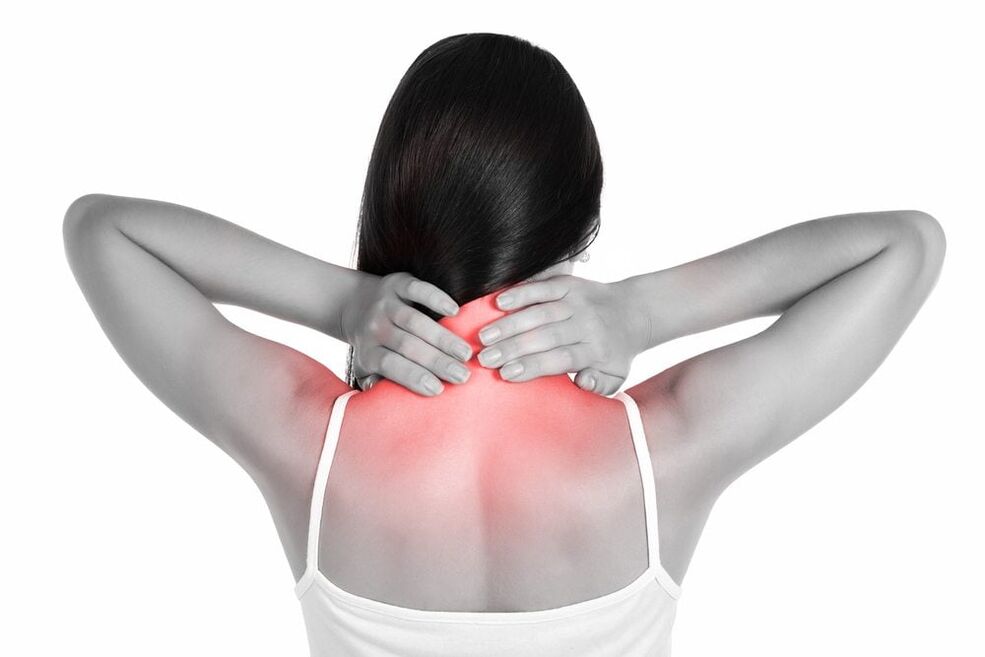
Classification of cervical pain
All pain in the neck is divided into acute and chronic. The first appeared suddenly and had obvious characteristics. They usually appear after hypothermia, strenuous exercise or weightlifting. For a long time, chronic pain will continue to bother a person. They are mild, have sore properties, and will worsen after sitting or sleeping in uncomfortable positions for a long time.
Depends on localizationPain is visceral, superficial and deep in the body. . . The first occurrence was due to damage to internal organs. Visceral (reflex) pain may indicate angina, esophageal or pharyngeal disease, acute thyroiditis, vertebral anatomy, or carotid artery.
Due to trauma or minor scratches, body pain with deep skin depth occurs deep in the tissues. The latter is usually caused by excessive muscle tension or spinal pathology.
How to distinguish visceral pain and body pain? The former are scattered in nature, that is, one cannot determine their exact location: they radiate to other parts of the body and are accompanied by nausea, vomiting, dizziness, fever, etc.
In 2008, the "Neck Pain Task" made the following recommendations:Tadia Cervical Pain:
- The patient did not have any symptoms suggestive of structural abnormalities. A person's daily activities are not restricted, and he does not need additional examination and treatment. This type of cervical pain will disappear after minimal lifestyle adjustments.
- The person has no signs of severe structural damage to the spine or cervical organs, but his daily activities are slightly impaired. Patients sometimes need painkillers. In order to prevent disability, he needs to change his lifestyle and take special exercises.
- The person has no signs of severe organic damage, but has neurological symptoms. Patients need additional examinations and complex treatments for the pathologies found.
- The patient noticed signs of organic changes. He is worried about severe neck pain, which usually means trauma, tumor, myelopathy, systemic disease, etc. Patients need to be carefully examined and receive specialized treatment.
Neck pain can be central and neurological. Central neck pain occurs in meningitis, acute cerebral circulation disease, TBI, increased intracranial pressure, and intracerebral tumors.Neuropathic pain occurs due to squeezing of the vertebral root, tunnel neuropathy, traumatic nerve injury, multiple neuropathy, multiple sclerosis, etc. . . .
Main causes of neck pain
Neck pain may occasionally occur or bother a person every day. Periodic cervical pain that occurs every few months is usually harmless and does not indicate any pathology. They disappear quickly after resting or applying anesthetics.
However, constant soreness or sudden severe neck pain can cause serious concern.
Table 1. Main reasons
| the reason | Mechanism of the development of pain syndrome | Pathological features |
|---|---|---|
| Work hard or do physical exercise | Large amounts of lactic acid are formed in the muscles. It is this substance that causes painful feelings. | Pain occurred the next morning after strenuous exercise. Hand movements and head turns can exacerbate the unpleasant feeling. after a few days |
| Low temperature | Occipital nerve innervates the development of neuralgia | Usually, a person feels pain under the ears under the neck and at the back of the head. In most cases, occipital neuralgia is located on one side: the pain only appears on one side |
| Psychosomatic medicine | Muscle formation-spastic contraction of the neck and shoulder girdle muscles | A person's neck is injured for no obvious reason. After a thorough examination, the doctor could not find signs of spinal disease or internal organ disease |
| Pathological biomechanics of the shoulder girdle | Disrupt the normal function of the muscles of the upper limb girdle. Hypertension and spasm of the trapezius muscle | The mobility of the shoulders and cervical spine is slightly reduced. After sitting in the same position for a long time or doing physical exercises, the pain will increase |
| Cervical Chondrosis | Pathological changes occur in one or more spine motor segments. Impaired spine mobility, development of myofascial pain syndrome and squeezing of the root of the spine | Pain, paresthesia, and dyskinesia in the neck area extend to the back of the head and upper limbs. Detect characteristic changes of the spine on MRI and X-rays (osteophytes, decrease in distance between vertebrae, signs of intervertebral joint damage) |
| Cervical and Arm Sciatica | The development of the inflammatory process that forms the brachial plexus | Severe pain radiated to one side of the upper limb. The patient complained of burning and numbness in the hands and back of the brain. Symptoms of hypothermia or discomfort after physical labor |
| Acute thyroiditis | Formation of inflammatory or purulent foci in the thyroid gland, which subsequently develops into a pain syndrome | Severe pain and swelling of the thyroid gland. On palpation, you will feel enlarged, painful, nodular glands |
| Colds and infectious diseases | Inhalation of cold air or inflammation of the mucous membranes of the pharynx, larynx, and trachea under the influence of infectious factors | Pain and sore throat, headache, runny nose, fever. General weakness, indifference, and decreased ability to work |
| Burns to the throat or esophagus | With the further development of the inflammatory process, high or low temperatures are exposed to chemicals in the mucous membranes | Severe pain in the esophagus, worse when swallowing |
| Tension headache | The muscles of the shoulder girdle are constantly over-tightened, frequently stressed, and depressed | Pain spreads to the head and spreads to the cervical spine area |
| Subarachnoid hemorrhage | The blood flows to the subarachnoid space to stimulate the meninges of the brain | Severe pain in the back of the head, reminiscent of a blow to the head |
| Multiple sclerosis | Further development of neurological symptoms, damage to myelin fibers in the brain and spinal cord | Sudden neck pain spread to the spine. The patient himself described his feeling as "electric shock" |
| Tumors of the spine, lungs, and neck organs | Compression of tissues, nerves or organs by malignant tumors | The pain lasts for a long time. Suffering from pharynx or esophagus tumors, people have difficulty swallowing food |
| Inflammation of the lymph nodes | In response to infections, hypothermia and other reactions, the development of the process of inflammation of the lymph nodes. | Pain on both sides of the neck. Painful lymph node enlargement can be felt when palpating along the sternocleidomastoid muscle |
Overwork or hypothermia
If the neck is injured after exercise, physical exertion or long-term monotonous work, it should be attributed to muscle strain. Vigorous physical activity can lead to the formation of lactic acid, which can cause severe pain. After 3-4 days, the discomfort disappeared completely.
Hypothermia may cause neck pain that radiates to the ears. . . The neuralgia of the occipital nerve develops due to the effect of low temperature. The pathological features are paroxysmal, shooting, and burning pain in the back of the brain. The pathology can be unilateral or bilateral.
Some people often feel neck pain after sleeping. This may be caused by the wrong choice of pillows. However, the feeling of pain may also indicate cervical osteochondrosis. Therefore, if the neck is injured after sleeping, the first thing to do is to change the pillow. If the pain syndrome does not go away, you need to see a surgeon or vertebral surgeon.
Psychosomatic pain
If your neck keeps hurting for no obvious reason, it may be a psychological problem. Depressed emotions, stubbornness and unilateral thinking may cause muscle blockage. In people with psychosomatic neck pain, the cervical spine muscles are regularly injured and stretched, but even after a thorough examination, doctors cannot find the cause of this phenomenon.
Recent scientific research has established a relationship between personality characteristics and the appearance of vertebral neck pain. Facts have proved that increased anxiety and aggressiveness promote the development of cervical osteochondrosis. The discovered relationship can be used to more effectively treat shoulder and neck vertebral pain in people with neuropathy or neurosis-like diseases.
Violation of the biomechanics of the shoulder strap
The cause of neck and shoulder injuries may be due to abnormal function of the shoulder girdle muscles. The weakness of the deltoid muscle and the overload of the trapezius muscle cause the appearance of myofascial trigger points, which leads to the development of pain syndromes. At first, the neck muscles are sore, but over time, organic changes in the spine appear.
Incorrect load distribution on the shoulder girdle muscles is a common cause of cervical pain. It is necessary to eliminate the cause, that is, to restore the normal biomechanics of the upper limb girdle. For this, you need to carefully monitor your posture and perform some special exercises.
Spinal osteochondrosis and its complications
Will the neck and spine between the shoulder blades continue to be injured? This may be a signal of the development of cervical osteochondrosis. The pathology is characterized by the gradual destruction of the nucleus of the intervertebral disc, followed by herniation, hernia, spondyloarthritis and cervical spondylosis.
Typical signs of osteochondrosis:
- Muscle pain in the neck and collar area;
- Numbness at the back of the head;
- Limited movement of the cervical spine;
- Violation of upper limb sensitivity;
- Slight weakness of the arm;
- Tinnitus, often dizziness, headache.
Patients with osteochondrosis not only injure the cervical spine. Due to reflex muscle tension, he suffered from myofascial pain syndrome. They are characterized by pain, paresthesia and numbness in the muscles of the back, girdle and upper limbs.
In the initial stage, use MRI to detect osteochondrosis. . . Later, the pathology can be diagnosed by X-ray examination. On the cervical spine X-ray film, the distance between the vertebrae is reduced, and the pathological changes and osteophytes of the small joints become obvious.
Many people complain that they cannot turn their necks due to the severe pain that occurs after a sharp increase in weight. A similar phenomenon indicates the formation of a herniated disc. The cause of pain in the back, neck, and upper limbs is that one of the nerve roots emerging from the spinal cord is squeezed.
Cervical and Arm Sciatica
The disease is characterized by inflammation of the spinal nerves involved in the formation of the brachial plexus. The cause of the inflammatory process may be acute poisoning, hypothermia, spastic muscles squeezing nerve roots,Intervertebral hernia or osteophyte. . .
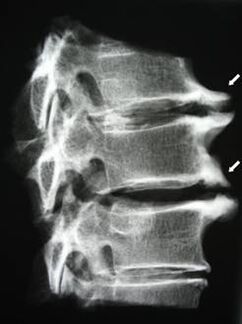
Patients with sciatica have severe pain in the neck, head, shoulders, and even upper limbs.. . . The pain has risen sharply, with a burning sensation. Many people complain of numbness behind the head, crawling arms, sensation and movement disorders in the upper limbs.
What should I do if my neck is injured, my head is turned, and my arm is difficult to move? Seek medical attention immediately. Cervical-brachial neuralgia and sciatica require serious treatment, and you cannot provide it yourself.
Thyroid disease
Most thyroid diseases are not accompanied by pain. And only in people with acute thyroiditis (thyroiditis), the front neck will be injured. In addition, patients may also experience elevated body temperature, chills, general weakness, body aches and other symptoms of poisoning. On closer inspection, you can feel enlarged and painful goiter. In some cases, several dense infiltrates were found in it.
For many people, the neck will be injured after a diagnostic thyroid puncture. The unpleasant feeling lasted for a few days. The cause of the pain is the trauma of the soft tissue during the operation.
Inflammatory diseases of the cervical organs
With inflammatory diseases of the pharynx and larynx, a person usually has a sore throat and inflammation of the lymph nodes in the neck. Pathological causes may be hypothermia, infection, use of low-quality alcohol or accidental exposure to chemical substances in the mucous membranes.Increased neck pain when swallowing, indicating involvement of the pharynx, throat or esophagus. . .
Diseases of neck and throat injuries:
- pharyngitis;
- laryngitis;
- Angina pectoris;
- diphtheria;
- Infectious monocytes;
- Scarlet fever
- Epiglottitis;
- Pharyngeal abscess
- Chemical burns of the esophagus.
The throat and neck on both sides are most common to catch colds. The cause of the disease is hypothermia, sudden inhalation of cold air or walking in the cold for a long time. A good rest, warm tea and some painkillers can help cope with this disease.
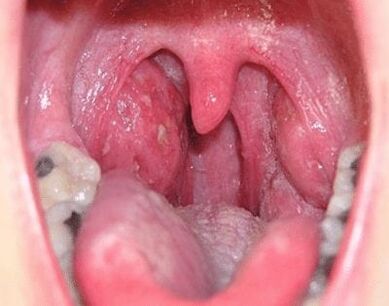
If the throat at the bottom of the neck is sore, pharyngitis or bronchitis (inflammation of the throat or trachea) should be suspected. Viral infection, inhalation of hot, cold or polluted air can induce the development of diseases. If the throat and neck are injured from behind, it may be a pharyngeal abscess. The pathological features are elevated body temperature, difficulty swallowing, loss of appetite, general weakness and apathy.
Damage to the central or peripheral nervous system
Subarachnoid hemorrhage can cause severe pain. The person himself described it as the feeling of "striking to the head" and moving the back of the head. The patient developed nausea, vomiting, confusion, and meningeal signs. About 6 hours after the first pain occurs, the neck will stiffen.
Meningitis has similar clinical manifestations.. . . The head and neck of people with meningeal inflammation are very uncomfortable. Pain increases with exercise. During the examination, the patient will expose the tension of the occipital muscle. Therefore, even with outside help, one cannot extend the chin to the chest. What followed was the typical rash that appeared on the patient.
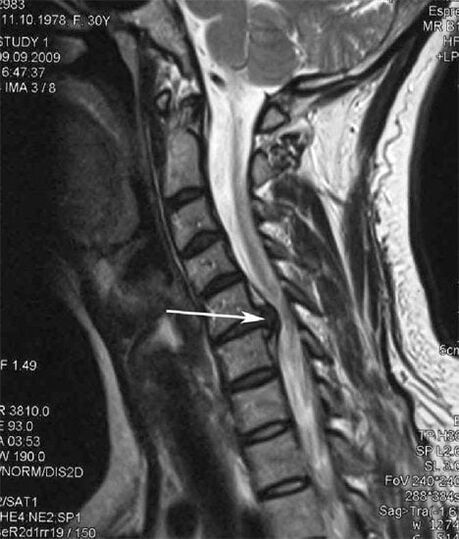
Neck pain may be caused by spinal cord or peripheral nerve damage, central nervous system tumors, demyelinating diseases, etc. All these diseases have polymorphic clinical manifestations, and pain is one of the pathological symptoms.
Pain in the back and spine may be one of the early symptoms of multiple sclerosis (demyelinating disease of the central nervous system). In people with this pathology, so-called Lemmett symptoms appear. It is characterized by the sensation of electric shock to the back of the head when the head is tilted back.
Malignant or benign tumor
Various tumors of the cervical spine, pharynx, esophagus, thyroid or other organs can also cause pain. In addition, people with Pancost cancer may experience pain, which is a malignant tumor located below the tip of the lung.
Muscle damage
In some cases, people suffering from myositis, polymyalgia, and fibromyalgia suffer damage to the muscles on the outside of the neck. These diseases are characterized by damage to any part of the skeletal muscle. If a person notices muscle soreness in the neck from the side for no obvious reason, then he may have one of these diseases.
If your neck muscles are painful in the front of your throat, remember if you have to scream loudly, sing or talk for a long time recently. Then, the cause of discomfort is that the vocal cords are too tight.
Other possible causes of cervical pain
Pain in the left side of the chest and pain in the collarbone extending to the neck usually indicate heart disease. In people with similar pain syndromes, angina, irregular heartbeat, heart failure or heart attack can be detected.
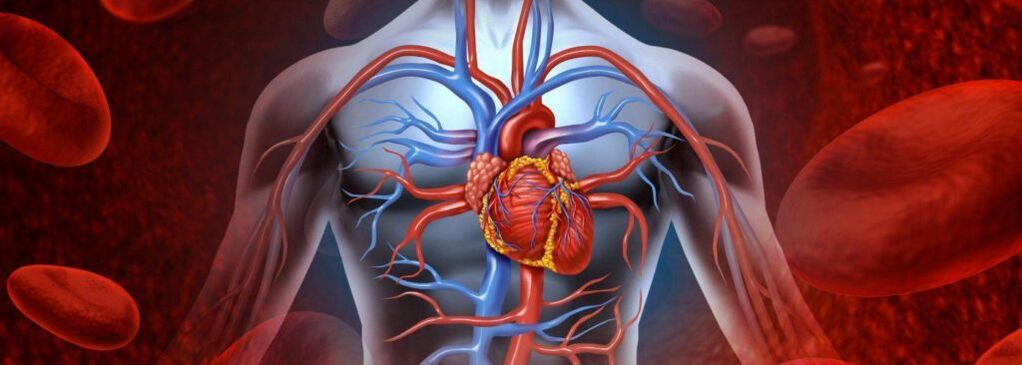
People suffering from dental caries, oropharyngeal or nasopharyngeal diseases will have injuries to the side of the neck. Tonsillitis can cause discomfort-inflammation of the tonsils. If pain is found in the shoulder near the neck, it may be due to scoliosis of the cervical and/or thoracic spine.
Why are the lymph nodes in the neck injured?
The cervical lymph nodes are located on both sides of the neck along the sternocleidomastoid muscle. Usually, they are small in size, but you can hardly find them. However, in some cases, the lymph nodes in the neck can become enlarged and injured. This phenomenon should be shocking, because it may indicate a serious disease or even a malignant tumor.
Most commonly, the lymph nodes in the neck become sore from inflammation (lymphadenitis).Pathological development is based on tonsillitis, rhinitis or acute respiratory virus infection. . . The reason may be that they failed due to tumor metastasis in the pharynx, esophagus, lung or other organs.
Signs of cervical lymphadenitis:
- Swollen lymph nodes. In some cases, their size may increase by 2-3 cm or more.
- The appearance of hyperemia and edema. Lymphadenitis is usually accompanied by redness of the skin and swelling of the inflamed lymph node area;
- Painful feeling. A person feels pain from one or both ears and the back of the neck at a time. It is difficult for patients to turn their heads to perform active exercises with their shoulders.
- Symptoms of poisoning. Increased body temperature, chills, general weakness, apathy, and headaches. The poisoning phenomenon appears as an acute form of lymphadenitis.
After prolonged exposure to draught, the cervical lymph nodes will become inflamed. In most cases, the ears and neck will have soreness under the ears. Slightly enlarged lymph nodes can be felt under the patient's skin.
The lymph nodes in your neck are swollen and injured, but you don't know what to do? It is best to see a doctor immediately. The specialist will examine you carefully and prescribe additional examinations. After passing the necessary tests, you can find out the cause of the pathology.
The most common causes of head and neck injuries
According to statistics, 70% of people with frequent headaches (headaches) have not only headaches, but also cervical spine.Cervical pain may be caused by painful irradiation or have a vertebral nature. Many men and women with osteochondrosis have neck pain and headaches. Of all headaches, 15-20% are of cervical origin.
Causes of pain in a person’s neck, head and temples:
- Overworked
- Violation of blood circulation in brain tissue;
- Cervical spine disease;
- Inflammation of the paranasal sinuses;
- hypertension;
- heart disease;
- Menopause
- Migraine
- The shoulder girdle muscles are overworked.
The most common type of headache is tension headache (HDN). It is caused by nervousness, severe mental activity or prolonged cramps of the neck, back and upper limb bands. For tension headaches, neck massage, foot massage and a small amount of painkillers are very helpful.
If you often have neck pain and dizziness, please don't hesitate. Massage the neck area and acupuncture can help cope with HDN. If you still feel soreness after the massage, you need a thorough examination. There may be serious problems behind mediocre headaches.
Why does the child feel neck pain?
Angina, acute respiratory virus infection, rubella, mumps, meningitis and other infectious diseases occur in babies with sore throats. If the child has neck pain on only one side, the cause may be otitis media, pharyngeal abscess, lymphadenitis, or trauma.
Speaking of childhood diseases, torticollis should be mentioned. The pathological feature is congenital shortening of the sternocleidomastoid muscle. Due to this defect, the baby's head is in a mandatory position. It will continue to appear and appear in the opposite direction to the defective muscle. A child with torticollis also has side pain in the neck. The main reason for this is continuous muscle strain.
what to do?Grab your baby and go to the hospital immediately. . . Seeking medical help in time will help you find the problem in time and start treatment.
Which doctor should I go to? It is best to see a pediatrician first. After the examination, the pediatrician will diagnose and prescribe or consult with a stricture specialist.
How to relieve acute neck pain
After hypothermia or weightlifting, some people complain: "My neck hurts, I can't turn my head. . . ". This symptom indicates acute inflammation of the root of the spinal cord or occipital nerve neuralgia. If you experience this kind of pain, you should always see a doctor.
To relieve pain, you can use tablets, gels or patches. In this case, it is best to use non-steroidal anti-inflammatory drugs, corticosteroids or warm ointments. Dry heat also has a good effect (heating pads, heated sand or grain bags).
I don’t know which doctor to see if I can’t tolerate neck pain? Since these neck pains usually indicate inflammation or nerve compression, it is best to see a neurologist immediately. He will prescribe appropriate treatments and block medications if necessary. Injecting corticosteroids can quickly and effectively relieve pain.
How to treat spine and neck pain
Neck pain is treated by a plastic surgeon or vertebral surgeon. After injuries to the cervix area and surgery, doctors prescribe Shants collars for patients. Analgesics and muscle relaxants can be used to relieve pain. In order to relieve muscle cramps and restore the normal biomechanics of the shoulder straps, experts recommend that you perform a series of exercises. Gymnastics therapy can exercise muscles and restore normal mobility of the spine.
If I get a neck injury during pregnancy, which doctor should I go to? First, you should visit the attending gynecologist. He will examine you and then send you to a specialist who will adequately treat you for consultation.




























